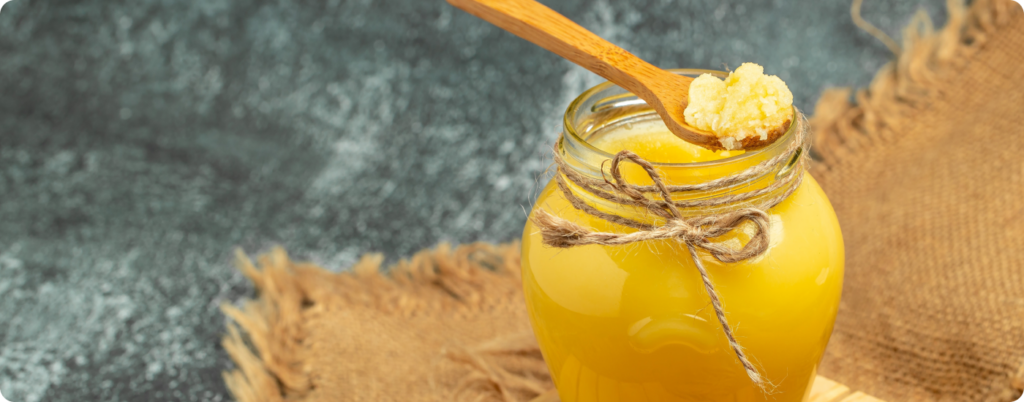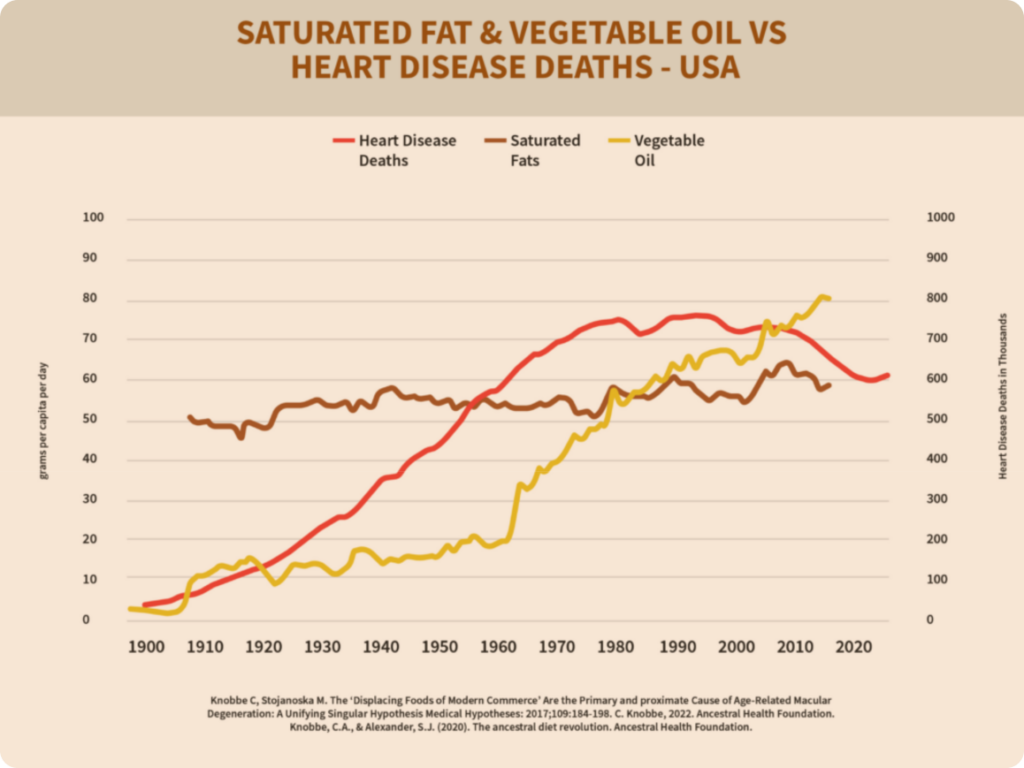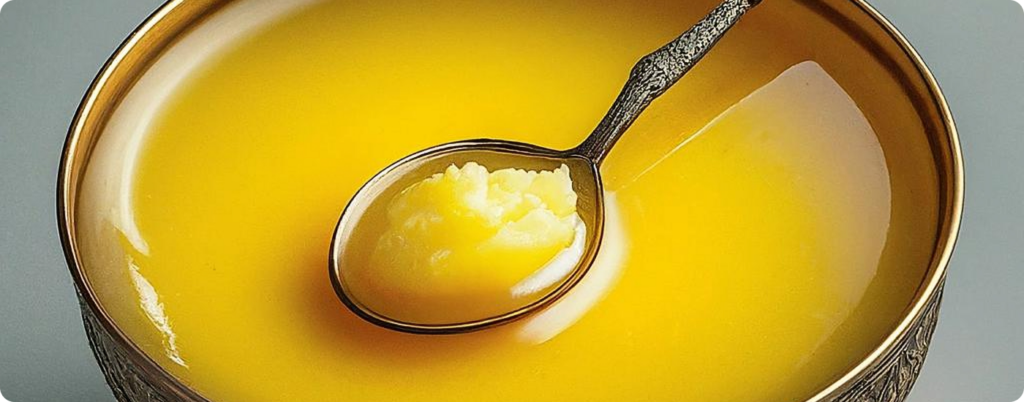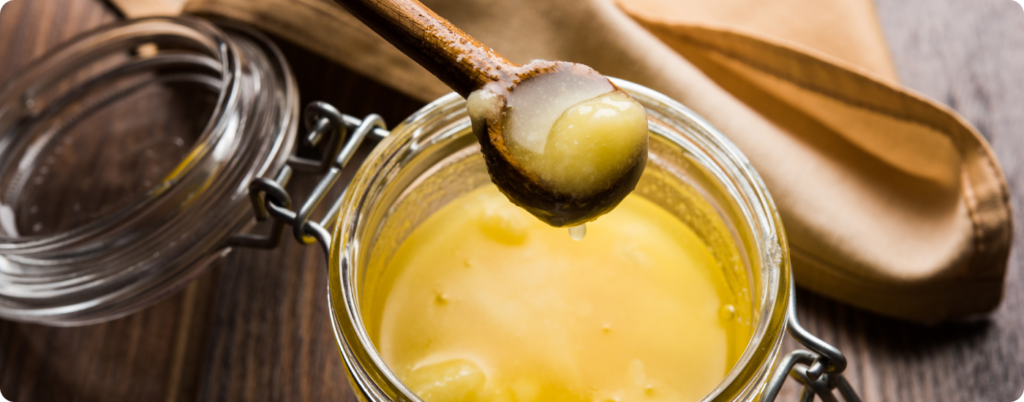Ghee has been cherished for centuries in traditional cultures. Today, it’s gaining renewed interest as a powerful fat for digestion, immunity, metabolism, and more.
With modern diets dominated by industrial seed oils, many are turning back to this golden fat for its nourishing, anti-inflammatory properties.
So what are the real ghee benefits? Let’s explore what the science and ancient wisdom say about why this clarified butter deserves a place in your animal-based diet.

What is Ghee?
Ghee is clarified butter made by gently simmering butter until the water evaporates and the milk solids separate. What’s left is pure, golden butterfat with a nutty flavor.
Ghee is composed primarily of stable saturated fat, including anti-inflammatory butyrate, and loaded with a wealth of fat-soluble vitamins (A, D, E, and K2), fueling hormone production and immune health.
The History of Ghee
In India, about 35% of all milk is converted to ghee, which has long been a staple in Indian cooking for its rich flavor profile and smooth texture. It is considered sacred and is also used in religious rituals (1).
Ayurvedic medicine treasures ghee as a healing food that nourishes digestion, enhances skin health, protects against allergies, and supports longevity. The Charaka Samhita, a foundational Ayurvedic text from around the 2nd century BCE, even lists it as one of the eleven foods traditionally recommended for daily consumption (2).
Saturated Fat: The Misunderstood Nutrient
Saturated fat has been wrongly vilified for decades, largely due to the flawed “diet-heart hypothesis” of the 1950s, which claimed a link between saturated fat to heart disease. While it’s true that saturated fat can increase LDL cholesterol, this isn’t inherently harmful. LDL is vital in transporting nutrients for hormone production, immune function, and cellular repair (3).
The real issue isn’t LDL itself but oxidized LDL, which is primarily driven by unstable polyunsaturated fats found in seed oils (4).
Ghee is rich in stable saturated fat, which may actually help protect against this oxidative damage, supporting rather than harming cardiovascular health.

Top 5 Ghee Benefits for Health
Here are some of the most well-researched and treasured ghee benefits:
1. Gut Health
Ghee is a natural source of butyrate, a short-chain fatty acid that nourishes the cells lining the intestinal walls and helps produce white blood cells that play a crucial role in fortifying the immune system (5).
2. Immune Health
Ghee supports immune resilience and lowers systemic inflammation with vitamins A and E, plus myristic acid and conjugated linoleic acid (CLA) (6, 7).
3. Anticancer
In animal studies, rats fed soybean oil developed larger and more frequent tumors than those fed ghee. Ghee was shown to suppress cancer-promoting enzymes and enhance detoxification pathways in the liver and mammary glands (8).
4. Heart Health
CLA can help reduce arterial plaque formation, lower triglycerides, raise HDL, and decrease fat accumulation in the liver. Ghee also improves the atherogenic index, a marker of cardiovascular risk. (9).
5. Skin Health
Topical ghee has long been used to support wound healing and inflamed skin (10). Internally, vitamins A and E help reduce oxidative stress and support collagen production, promoting healthy, glowy skin (11).
Ghee vs Butter
While both are nourishing, ghee has several advantages:
- Higher Smoke Point: Ghee is stable up to 482°F, making it ideal for high-heat cooking.
- Lactose-Free: The milk solids (casein and lactose) are removed in the process of making ghee, making it easier to digest.
- More Concentrated Nutrients: Because water and milk solids are removed, ghee is slightly richer in fat-soluble vitamins.
Butter does contain more caproic, capric, and lauric saturated fatty acids, which support metabolism and immune health (12). Using both ghee and butter in an animal-based diet is a great strategy.

Ghee vs. Tallow
Tallow, rendered beef fat, is another fat our ancestors have been consuming for centuries. While it has fewer fat-soluble vitamins present than ghee, it does stand out in one major way: tallow is rich in stearic acid, a pro-metabolic fat that supports mitochondrial function and fat oxidation (13).
For weight loss or energy optimization, pairing tallow (like what’s in Firestarter) with ghee is a metabolic power move.
Choosing the Best Ghee
Are you ready to add ghee to your animal-based diet? Fortunately, you can find it at most grocery stores, typically near the cooking oils or ethnic foods.
The quality of ghee depends mainly on how the cows are raised and fed since their diet directly influences the nutrient content of the milk.
Here’s a quick guide:
Good: Conventional Ghee (Grain-Fed Cows)
- Made from the milk of cows fed typically fed corn and soy, conventional ghee still offers health benefits but has fewer fat-soluble vitamins due to the cows’ grain-based diet.
Better: Organic Ghee
- Organic ghee comes from cows raised without hormones or synthetic chemicals. While it’s a cleaner option than conventional, it’s often still made from grain-fed cows, so it doesn’t have as high of a nutritional value as grass-fed.
Best: Grass-Fed Ghee
- Grass-fed ghee is the most nutrient-rich, offering higher levels of vitamins A, D, E, and K2, plus more beneficial fatty acids (14). It’s also more flavorful, making it the best choice for both health and taste.

How to Use Ghee
Ghee is one of the most versatile and flavorful fats you can use in the kitchen. Its high smoke point and rich nutty flavor make it perfect for everyday cooking and ancestral nourishment:
- High-heat cooking: Sear your stake, make sweet potato fries, or fry your eggs in ghee for a golden crispy edge.
- Baking and roasting: Use ghee to roast squash or sweet potatoes.
- Finishing oil: Drizzle melted ghee over rice.
If you’re feeling adventurous, you can even learn to make your own ghee at home!
Ghee Benefits: The Bottom Line
Ghee is a time-tested fat that supports digestion, immunity, heart function, and metabolic health. In a society overrun with industrial oils that harm cellular energy in excess, ghee stands as a time-tested ally.
If you’re seeking vibrant long-term health, ditch the seed oils and return to the ancestral fats such as ghee, butter, and tallow that have fueled us for generations. Your entire body will thrive when you nourish it the way nature intended.
Subscribe to future articles like this: